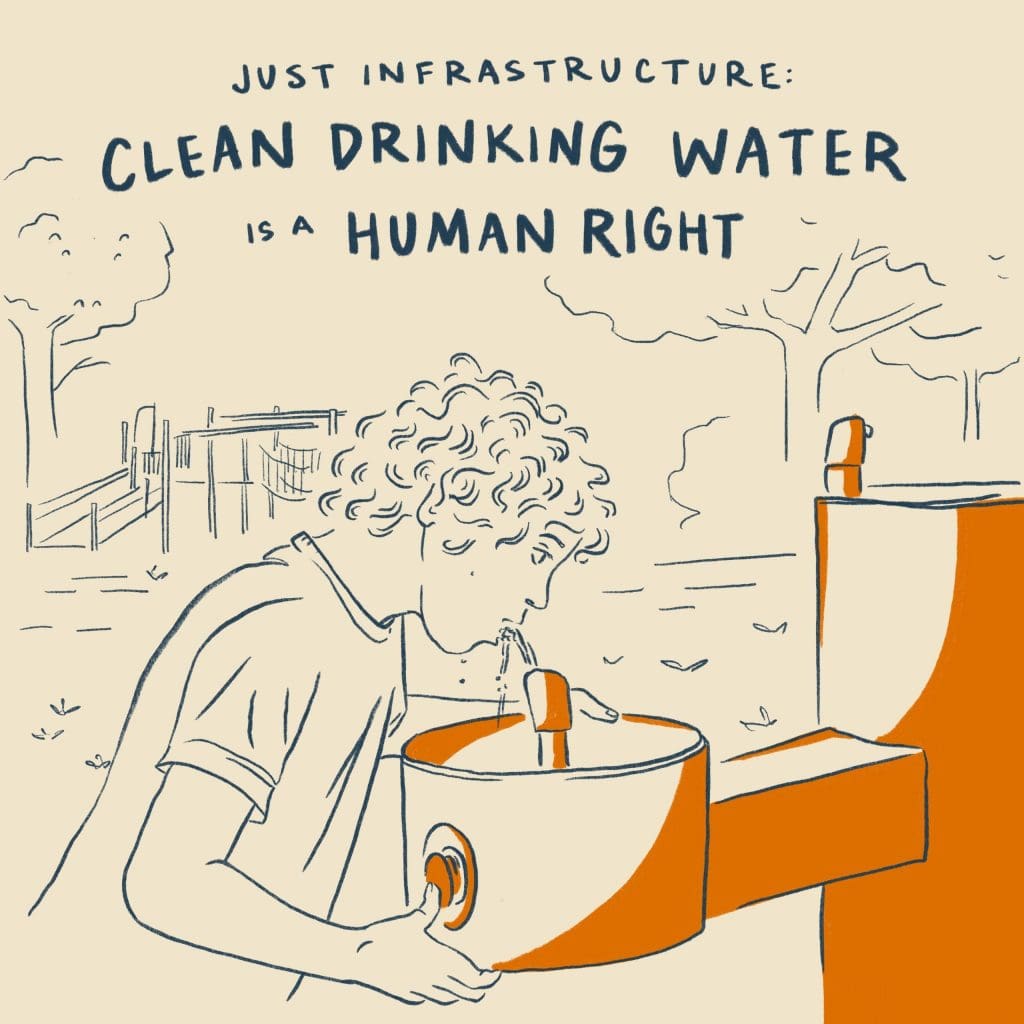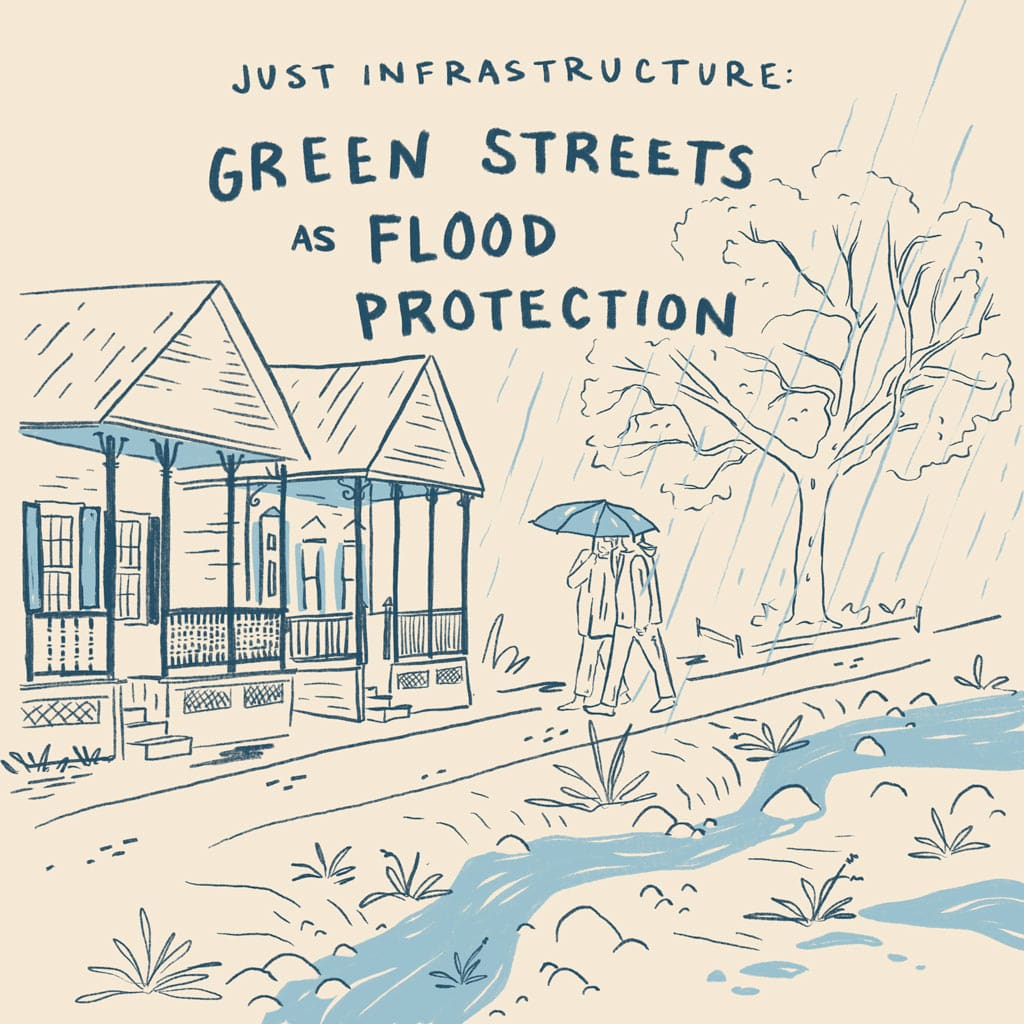In February 2024, we launched Just Infrastructure, a creative campaign based on dozens of conversations with advocates, practitioners, experts, and artists. The campaign is focused on the benefits and implementation of the Bipartisan Infrastructure Law and Inflation Reduction Act’s water programs. We wanted to center the call for justice in water spending while also creating a toolbox — from fact sheets to message guides, graphics and videos — for water champions to celebrate progress and push for targeted investments in their communities.
At the end of the year, we wanted to reflect on what we learned and where we go from here. Watch the webinar recording below and read on for highlights.
Just Infrastructure is more than just money
Months of work went into the research and production phase of the campaign ahead of the February launch. In addition to dozens of partner interviews, and our own research, we brought on three artists and organizers as fellows to shape the campaign from the ground up — consulting on brand identity and strategy for the campaign to create beautiful artwork and video.
Shout out Dillon St. Bernard, Shearon Roberts, and Dio Cramer!



Our goal was to tell a story about the benefits of targeted water investments beyond the money attached. Instead of hundreds of disparate stories about different pots of government funding, we organized the campaign around three content pillars: weather whiplash and drought resilience, the human right to water and sanitation, and flood justice. Each section includes specific artwork, social media graphics and posts, case studies, and resources like fact sheets and message guides. We focused on the ways of working with nature rather than trying to control nature as infrastructure too.
The visual identity translated into the campaign’s animated video, created in partnership with Silkworm Studio. Combining artwork, mixed media, music, and authentic conversations with clean water advocates allowed us to lean into a shared vision for the world we can create by investing in water and community. This project embodies our efforts to merge art and policy together!
Digital takeaways
Originally, we planned to complete the animated video for the launch of the campaign. Time and capacity wouldn’t allow for that and we accidentally stumbled into a phased rollout.
Three campaign phases
- In February, we launched the JustInfrastructure.org website and a social media campaign introducing each theme through artwork, a case study, and explainer carousel.
- We released the animated video as a second phase of the campaign. While unintentional, the video breathed new life into the campaign and extended its relevance.
- Lastly, we partnered with social media influencers to do storytelling around how these laws support the human right to clean water and sanitation.
Analytics and learnings
- Working intentionally with artist collaborations, we were pushed to create simple, human-centered illustrations that allows people to envision a better world. This proved successful, as the artwork moved people, and outperformed the case studies and photographs on social media.
- The top themes of the campaign, as judged by web traffic and social media engagement, were flood justice and the human right to water.
- Storytelling centered on the folks closest to the community, like an interview with Houston resident and advocate, Ben Broadway, performed best on video-first social media platforms like Instagram.
- Our best-performing influencer collaborations combined facts with hopeful messaging around safe drinking water access. “Collaborative” posts on Instagram (ones that show up on multiple accounts) increased traffic and engagement, lifting all boats.
- We explored sharing the animated video on niche platforms like Reddit, targeting communities like r/infrastructurist and r/civilengineering. This experimentation led to interesting conversations in the comments but also some shade from civil engineers who didn’t vibe with the aesthetic or message of the campaign. This kind of intel helps us target our audiences better in the future as we work to move people.
Influencer engagement
Why work with influencers and content creators? 75% of the country’s “rigorous” journalism now lives behind a paywall and more than half the counties in the U.S. have little to no local news. We find more people are getting their information from social media, and this is increasingly true for younger, less white, and lower income audiences. We need to meet the people where they are at! Otherwise, we are ceding narrative ground to alternative points of view and even mis- or disinformation.
We worked with creators across different geographies and backgrounds ranging from a water protector from Minnesota, a community organizer in Texas, an urban history buff in New York, and a teen from Flint. Across social media, these influencer videos were viewed over 230k times, with 26k replays, and 25k engagements reaching new audiences and inviting people to learn more.
@arielviera ? Do you think access to clean water and sanitation is a human right? Here’s the history of various water crises in American history. Follow @_waterhub on instagram and visit justinfrastructure.org to learn more. All opinions are my own. Sponsored by The Water Hub through funding from the Robert Wood Johnson Foundation. #newyorkcity #JustInfrastructure
♬ original sound – Ariel Viera
@kweenwerk Over 9 million U.S. homes still get water through lead pipes. Up to half of our water supply might be tainted with “forever chemicals.” Inequities in our water systems run deep. Over 2 million people in the U.S. lack running water, including 30% of families in the Navajo Nation. Access to clean water is a right, not a privilege. With over $60 billion allocated for water projects, we’re moving towards a future where everyone can turn on the tap without hesitation. Follow @_waterhub and visit justinfrastructure.org to learn more. ?? All opinions are my own. Sponsored by The Water Hub through funding from the Robert Wood Johnson Foundation. #ad #cleanwaterforall #waterisahumanright #justinfrastructure #gettheleadout #bipartisaninfrastructurelaw #inflationreductionact #waterislife #leadfreewater
♬ original sound – ? Kween werK ?
What we learned
- The influencer partnerships generated high engagement and views and helped to humanize and diversify the messengers spreading awareness.
- We held a kick-off meeting and provided materials to guide the videos, but allowed creators to use their own voices and experiences. Stories like Alexia LaClerq’s in TX or Little Miss Flint’s (the amazing Mari Copeny) were personal and engaging.
- People are really eager to work with influencers more! We have gotten a lot of questions about how to research, approach, and collaborate with creators on campaign storytelling. Luckily, we have a resource for that! This guide to working with influencers covers guidelines, outreach examples, and even template contract language. Check out our blog for some takeaways from another past campaign.
Earned media takeaways
In addition to the advocacy and digital components of Just Infrastructure, we also wanted to raise awareness of the benefits of water infrastructure investments through the media. This is probably the place we experienced the greatest challenge. We had observed that the vast majority of water infrastructure coverage, especially as it related to the Bipartisan Infrastructure Law and IRA, focused on funding awards and announcements, rather than community benefit. Changing that landscape is more than any one organization can do alone, and we struggled!
What we accomplished
- Throughout the campaign, we hosted a series of media briefings for journalists that focused on different themes and geographies. The goal of these briefings wasn’t necessarily to generate immediate press coverage (though we did get some!) but to introduce journalists to new ideas and new speakers and organizations. We covered topics like community-based infrastructure in the Great Lakes, nature-based solutions in the Upper Colorado River Basin, and building resilient disaster response.
- We placed op-eds from partners about how this water infrastructure moment can be used to envision a different world, like ‘unbuilding’ to better weather extremes, or bring additional benefits, like job creation, to places replacing lead pipes.
What we learned
- We knew we’d be swimming upstream to get past the quick hits focused on funding. Long project timelines, a lack of visual interest, or a timely “hook” stymied interest from journalists. Compelling stories aren’t enough. When pitching reporters, always remember you need to be able to answer the question, “Why now?”
- We found the most success when we got more local. This was more time intensive, with a smaller geographic footprint, but proved more successful than trying to tie together stories from across the country on a similar theme.
- Having spokespeople who are implementing projects and can speak directly to the challenges and benefits generated the most interest and led to the most compelling, in-depth news coverage.
What’s next?
Our policy future is uncertain given November’s election results, but we still feel like our learnings from the Just Infrastructure campaign will help guide us in 2025 and beyond. Water was actually a winner at the ballot box. When faced with a clear ballot measure, California, Minnesota, Colorado, and New York voters overwhelmingly chose to invest in water infrastructure, water conservation, and climate resilience. No matter who someone picked at the top of the ticket, when given an up or down choice, most folks say yes to water.
That doesn’t mean we aren’t facing a difficult political environment, but we believe the following principles will carry us forward:
- Values-led communications centered around health, safety, and family provide common ground across political ideology.
- Messages rooted in the impacts and improvements for drinking water generate the most concern and support from voters.
- Diversifying our communications strategies beyond traditional media will reach more people and get past some of the gaps in trust in institutions.
- It’s important to make it clear how people can get involved to actualize our vision of having access to clean water and thriving communities. Only raising problems with no solution or clear way to take action can lead to apathy. Anger and hope are powerful motivators, but need a little urgency and opportunity for action to get people moving.
Stay in touch
Sign up for our monthly-ish newsletter to stay in the loop with future Water Hub training and resources. You can also follow us on X (Twitter), Threads, Instagram, LinkedIn, Bluesky and YouTube.